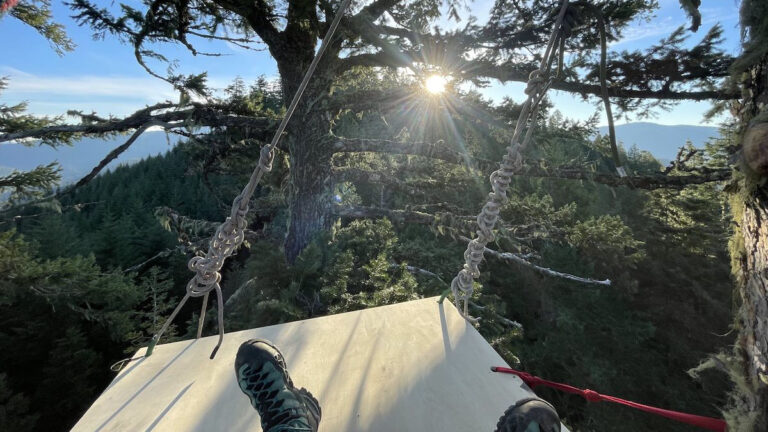by Kerul Dyer
Climate and forest defenders occupying a portion of an active logging site near Wolf Creek say they’re not going anywhere, anytime soon.
The site of the tree sit occupation, in a towering sugar pine estimated at more than 400 years old, lives within the BLM’s “Poor Windy” project. The 15,000 acre active logging operation exposes the agency’s reckless policy of destroying habitat for endangered species and the targeting of mature forests.
“In 2024, it is unbelievable that federal agencies continue to log irreplaceable, carbon rich, old growth and mature forest that helps to protect communities from out of control wildfire,” said Salal Golden from Pacific Northwest Forest Defense – who currently resides on a platform nestled among the top branches of a tree. “Protecting these forests is critical not just for our climate, but for our safety.”
According to a press release from the group, the Poor Windy project would log 4,573 acres of mature and old-growth trees that are essential nesting, roosting and foraging habitat for the threatened northern spotted owl and many other species. The project is one of many that include logging in Late Successional Reserves, that were designed to help keep remaining old forests intact.
“While we have seen some progress on logging practices from agencies like the Forest Service, the Bureau of Land Management is stuck in fifty years in the past, and has refused to stop its practice of targeting mature and old growth forests for cutting,” said Sam Shields, a local community member and forest activist. “In Oregon alone, the agency is targeting over 100,000 acres of forest for industrial logging with little consideration of the impacts to rural communities and the climate.”
The direct action response from the community comes on the heels of a commitment by the Biden Administration to end the practice of Old Growth logging on public lands by 2024. It also coincides with a new landscape level management planning process that would increase protections for forests across the entirety of the BLM’s management area.
In addition to these contradictions, local conservation group KS Wild filed a lawsuit challenging another of the agency’s pivotal policies, called Integrated Vegetation Management (IVM). IVM designation allows the agency to sidestep much of it’s routine environmental review in timber sale planning in an apparent effort to access more Late Successional Reserves, especially in the Applegate Valley.
“BLM is saying we don’t log old growth trees,” said George Sexton a longtime conservation advocate with Klamath Siskiyou Wildlands. “Well, people are sitting in old-growth trees that the BLM wants to log.”


